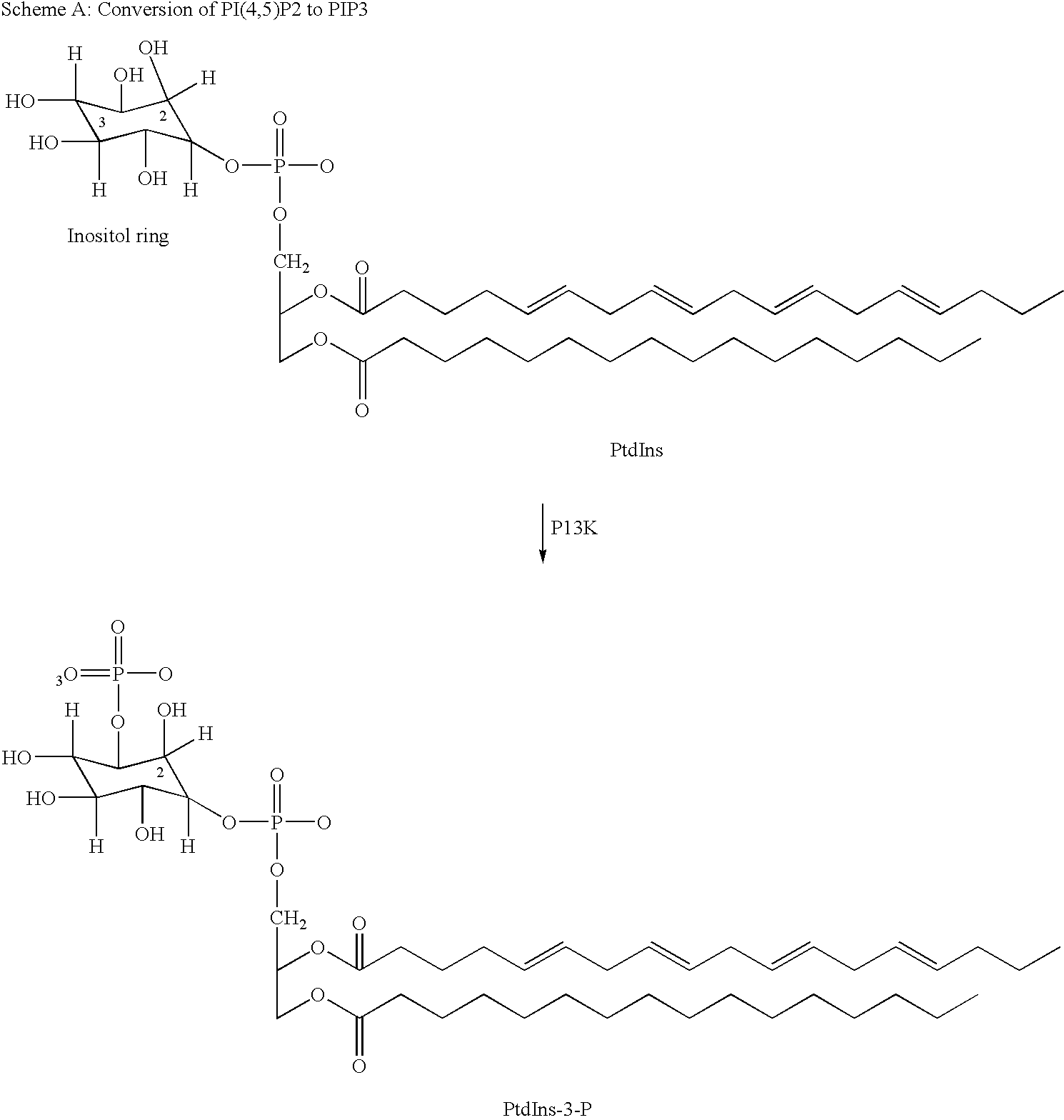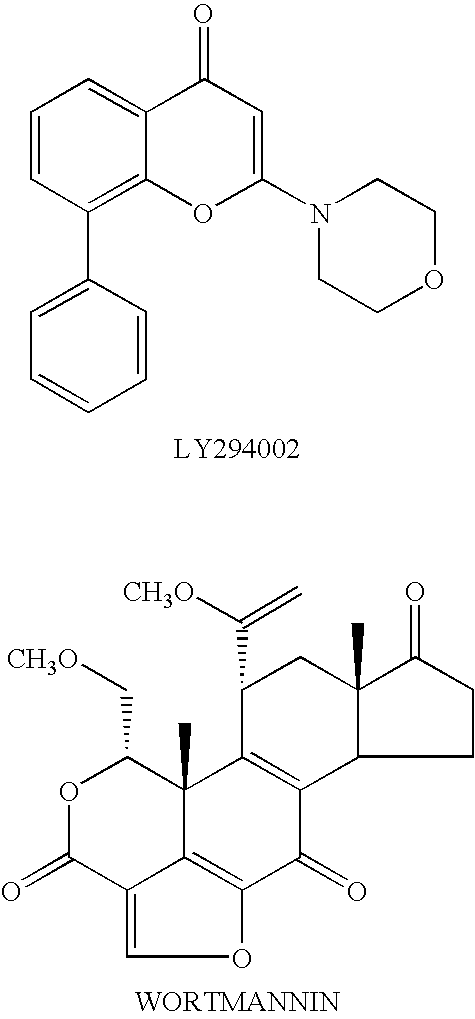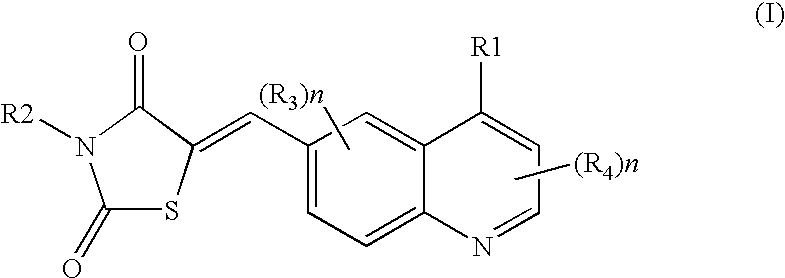Thiazolidinedione derivatives as p13 kinase inhibitors
a technology of thiazolidinedione and kinase inhibitor, which is applied in the field of thiazolidinedione derivatives, can solve the problem of limited expression of the enzym
- Summary
- Abstract
- Description
- Claims
- Application Information
AI Technical Summary
Benefits of technology
Problems solved by technology
Method used
Image
Examples
example 1
(5Z)-5-{[4-(4-pyridinyl)-6-quinolinyl]methylidene}-1,3-thiazolidine-2,4-dione
[0178]
a) 4-chloro-6-ethenylquinoline
[0179]A mixture of 6-bromo-4-chloroquinoline (6.52 g, 26.88 mmol; see J. Med. Chem., 21, 268 (1978)), tributyl(vinyl)tin (8.95 g, 28.22 mmol), and tetrakistriphenylphosphine palladium (0) (0.62 g, 0.54 mmol) in 1,4-dioxane (150 mL) was refluxed for 2.0 h, cooled to room temperature, and concentrated in vacuo. The residue was purified by flash chromatography on silica gel (0-4% MeOH:CH2Cl2) to give the title compound (5.1 g) as a pale yellow solid. MS (ES)+m / e 190 [M+H]+. This material was used directly in the next step.
b) 4-chloro-6-quinolinecarbaldehyde
[0180]A mixture of 4-chloro-6-ethenylquinoline (5.1 g, 26.88 mmol), 2,6-lutidine (5.76 g, 53.75 mmol), sodium (meta) periodate (22.99 g, 107.51 mmol), and osmium tetroxide (5.48 g of a 2.5% solution in tert-butanol, 0.538 mmol) in 1,4-dioxane:H2O (350 mL of 3:1 mixture) was stirred for 3.5 h at room temperature and concent...
example 2
(5Z)-5-{[4-(3-pyridinyl)-6-quinolinyl]methylidene}-1,3-thiazolidine-2,4-dione
[0183]
[0184]Following the procedure used to prepare Example 1, the title compound was prepared by substituting 3-pyridinylboronic acid for 4-pyridinylboronic acid. MS (ES)+ m / e 334 [M+H]+.
example 3
(5Z)-3-methyl-5-{[4-(4-pyridinyl)-6-quinolinyl]methylidene}-1,3-thiazolidine-2,4-dione
[0185]
[0186]Following the procedure used to prepare Example 1, the title compound was prepared by substituting 3-methyl-1,3-thiazolidine-2,4-dione in place of 1,3-thiazolidine-2,4-dione, to give a light yellow solid. MS (ES)+ m / e 348 [M+H]+. Alternatively, some examples were prepared via a palladium mediated Suzuki (or Stille) coupling of a heteroaryl boronic acid (or heteroaryl stannane) with 4-iodo-6-quinolinecarbaldehyde (Scheme II). The iodide intermediate was prepared by treating the corresponding chloride with 4 N HCl, followed by sodium iodide. The heteroaryl aldehydes were converted to the title compounds following the same procedure used to prepare Example 1.
Example 4
(5Z)-5-([4-[2-(methyloxy)-5-pyrimidinyl]-6-quinolinyl]methylidene)-1,3-thiazolidine-2,4-dione
[0187]
a) 4-iodo-6-quinolinecarbaldehyde
[0188]In a large reaction tube, to a solution of 4-chloro-6-quinolinecarbaldehyde (4.26 g, 22....
PUM
| Property | Measurement | Unit |
|---|---|---|
| volume | aaaaa | aaaaa |
| pH | aaaaa | aaaaa |
| temperature | aaaaa | aaaaa |
Abstract
Description
Claims
Application Information
 Login to View More
Login to View More - R&D
- Intellectual Property
- Life Sciences
- Materials
- Tech Scout
- Unparalleled Data Quality
- Higher Quality Content
- 60% Fewer Hallucinations
Browse by: Latest US Patents, China's latest patents, Technical Efficacy Thesaurus, Application Domain, Technology Topic, Popular Technical Reports.
© 2025 PatSnap. All rights reserved.Legal|Privacy policy|Modern Slavery Act Transparency Statement|Sitemap|About US| Contact US: help@patsnap.com



